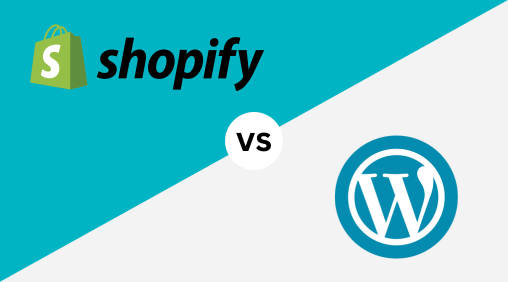If you want to build an online store or optimize an existing platform, you’ll almost inevitably run into the question: Shopify vs WordPress— which system fits your needs better?
Both are among the world’s best-known e-commerce options, but they follow very different approaches: Shopify as a cloud-based SaaS platform, and WordPress combined with WooCommerce as a flexible open-source solution.
This decision affects more than your initial setup—it shapes your long-term costs, scalability, security, marketing capabilities, and day-to-day workload. Shopify stands out for ease of use and predictable pricing, while WordPress offers maximum freedom and virtually unlimited customization—at the price of higher maintenance effort.
For businesses, this means weighing what matters more: speed and efficiency, or full control and individuality. This article gives you a solid orientation, shows the differences in a practical way, and helps you choose the right platform for your business model.
WordPress vs Shopify: e-commerce platforms compared
In a time when e-commerce is growing rapidly and consumers expect top-tier performance, user experience, and omnichannel availability, you need to make sure your platform doesn’t become a bottleneck.
Your tech stack determines how quickly you can respond to market changes, which marketing strategies you can execute, and how smoothly you can scale into new markets.
There’s no universal “better” or “worse.” The key question is whether the platform supports your goals, your team setup, and your resources. So if you’re building an e-commerce shop, it’s worth looking closely at the differences between Shopify and WordPress.
|
Question / Criterion |
Shopify |
WordPress |
|
Start quickly without technology? |
✅ Yes, SaaS, hosting & updates included |
❌ Only with your own setup & hosting |
|
Flexibility & Individualization |
Limited but stable |
Maximum customizability, full code control |
|
Maintenance & Security |
Automatically through Shopify |
Self-responsible (or agency required) |
|
Target group |
Startups, DTC brands, SMEs |
Content-driven shops, complex setups |
|
focus |
Efficiency & Scalability |
Individuality & full control |
This highlights the core difference: Shopify prioritizes speed, efficiency, and low-maintenance operations, while WordPress enables almost unlimited customization—at the cost of higher technical and organizational effort.
Which platform makes more sense depends heavily on where you’re starting from. That’s why it’s useful to look at which audiences and use cases each system serves best.
E-commerce platforms: first orientation & target audience
The best fit depends on your business model. Shopify is ideal if you want to launch fast and operate efficiently, while WordPress shines in complex, content-driven projects.
Shopify is especially suitable for:
- Startups and DTC brands that want to go live quickly
- Merchants without an in-house dev team (low maintenance; hosting & updates included)
- Mid-sized businesses focused on growth, conversion, and scalability
- Companies that prefer clear processes and want to expand internationally
WordPress is especially suitable for:
- Projects that tightly connect content & commerce (e.g., blog + shop)
- Businesses with unique workflows or specialized pricing/product logic
- Brands with a strong focus on custom branding and design freedom
- Companies willing to invest in tech, maintenance, and agency support
In short: SaaS platforms are built for efficiency, open-source solutions for maximum freedom.

Core principles: Shopify vs WordPress
Shopify is a pure SaaS e-commerce platform. Hosting, updates, security, and infrastructure are handled by the provider.
That means:
- no server management needed
- automatic updates
- 24/7 support and monitoring
- direct access to themes, templates, and apps
For many merchants, this is ideal because it keeps focus on products, marketing, and sales—not on maintaining servers and software.
WordPress works differently. It’s a CMS originally built for blogging. With the WooCommerce plugin, it becomes a flexible e-commerce solution.
Key traits:
- full access to code
- deep customization via plugins and themes
- freedom to choose hosting and infrastructure
- large community with thousands of extensions
You get maximum control—but you also take responsibility for updates, backups, and security (or you pay an agency to manage it).
Ease of use & setup: WordPress vs Shopify
Ease of use is a major differentiator.
Shopify
- Setup without prior knowledge: sign up, choose a theme, add products—live within hours
- Themes: vetted, mobile-optimized themes with an easy visual editor
- Apps: 8,000+ apps, integrated and update-safe
- Day-to-day: very visual, stable, ideal for non-technical teams
WordPress
- Setup: hosting, installation, SSL, theme + plugins—often requires technical skills or external help
- Themes: huge selection, high flexibility, but potential compatibility issues
- Plugins: 50,000+ extensions, but higher risk of instability and maintenance overhead
- Day-to-day: powerful, but more complex—requires ongoing upkeep
In practice, Shopify prioritizes stable workflows and a smooth UI, while WordPress demands more technical familiarity.
A direct comparison shows how these differences are noticeable in everyday life:
|
Workflow |
Shopify |
WordPress + WooCommerce |
|
Product plant |
Simple, visually guided |
More complex, more options |
|
Change layout |
Drag & Drop |
Often intervention in templates necessary |
|
Multilingualism |
Integrated |
Plugin-based |
|
Error susceptibility |
Small amount |
Higher through manual intervention |
Conclusion: Shopify is built for simplicity and stable operations—ideal for fast launches. WordPress offers almost unlimited design freedom, but comes with much more technical complexity and maintenance.
Costs & pricing: direct comparison
Your platform choice also defines long-term costs. The entry price is often just the tip of the iceberg—ongoing spending for hosting, maintenance, support, and extensions can add up significantly over time.
|
Cost factor |
Shopify |
WordPress |
|
Start-up costs |
from 36 €/month, incl. hosting & SSL |
free, hosting from 10-50 €/month |
|
Hosting |
inclusive, scalable |
variable, depending on provider & traffic |
|
maintenance |
automatically |
Agency or IT team required (100-300 €/month) |
|
Extensions & Themes |
Apps usually 5-20 €/month, themes from 100 € |
Plugins often free, premium + updates expensive |
|
Transaction fees |
1.4-2.9% (except with Shopify Payments) |
depends on the payment provider (PayPal, Stripe) |
|
Support |
24/7 included |
Community forum or agency (fee required) |
|
Security |
integrated (SSL, PCI-DSS) |
additional plugins or agency costs |
|
Scaling |
higher rates depending on needs |
rising server & plugin costs |
|
Enterprise version |
from €2,000/month (Shopify Plus benefits) |
from €22,000/year (Adobe Commerce Enterprise) |
Conclusion: Shopify offers predictable costs and reduces hidden expenses for maintenance, security, and support. WordPress looks cheaper at first, but can become more complex—and often more expensive—over time as your shop grows.

Features & daily workflows
Daily workflows define how efficiently you can operate.
Shopify
- Catalog management: streamlined, efficient
- Payments: Shopify Payments integrated; PayPal/Klarna etc. easy to add
- Shipping & fulfillment: built-in options + apps like Sendcloud
- Multichannel & POS: native social selling + POS integration
- Scaling: automatic scaling; Plus adds headless and international features without server work
- Maintenance: handled by Shopify
- Operational effort: low
WordPress + WooCommerce
- Catalog management: flexible, but more setup-heavy
- Payments: via plugins; configuration can be more complex
- Shipping & fulfillment: third-party plugins; setup varies
- Multichannel & POS: plugins or middleware; POS via third parties
- Scaling: possible, but requires strong hosting, devops, extra tooling
- Maintenance: your responsibility
- Operational effort: high
Conclusion: Shopify reduces operational overhead and includes many features out of the box. WooCommerce offers maximum flexibility, but needs more resources for setup, maintenance, and security.
SEO & Marketing
Visibility and sales performance depend heavily on SEO and marketing features.
Shopify
- SEO: strong baseline—fast load times, SSL, clear structure built in. Apps like Plug in SEO or Smart SEO help optimize meta data and images.
- Conversion: many CRO tools in the app store—A/B testing, upsells, personalization—quick to deploy and stable.
- Content: basic blogging built in; enough for many brands, but limited for large content hubs.
WordPress
- SEO: plugins like Yoast SEO or Rank Math allow deep control (canonicals, schema, sitemaps). Powerful—but misconfiguration and plugin conflicts are risks.
- Conversion: strong funnel plugins exist, but require more setup and maintenance.
- Content: WordPress’s biggest strength—ideal for blogs, landing pages, and editorial content at scale.
Shopify is great for fast SEO + conversion wins. WordPress is strongest for content-heavy strategies and custom needs—but requires more upkeep.

Pros & cons of Shopify
If you want to launch quickly without worrying about technical maintenance, Shopify is a strong choice. Hosting, security, and updates are handled for you, and international selling plus social integrations are built in.
Pros
- Start fast without technical knowledge
- Hosting, updates, and security included
- 24/7 support
- Large app store with vetted extensions
- Easy internationalization (languages/currencies)
Cons
- Monthly subscription fees
- Extra transaction fees if using external payment providers
- Deep checkout customization typically requires Plus
- Less flexibility than open-source systems
|
Advantages |
Disadvantages |
|
Ready to go quickly without any technical knowledge |
Monthly subscription fees |
|
Hosting, updates & security included |
Additional transaction fees for external payments |
|
24/7 support directly from the provider |
Less flexibility than open source |
|
Stable app ecosystem with tested extensions |
Checkout fully customizable only in the Plus plan |
Pros & cons of WordPress (WooCommerce)
If you want maximum control and flexibility, WooCommerce is compelling. You can customize almost anything and combine content marketing with your shop seamlessly. But you’re responsible for hosting, updates, and security—or you’ll need an agency.
Pros
- Core software is free
- Full code control and customization
- Huge plugin/theme ecosystem
- Excellent for content marketing and SEO
- Large community support
Cons
- High ongoing maintenance (updates, backups, security)
- Plugin conflicts can slow down or break sites
- Technical knowledge or agency support often required
- Security depends heavily on setup quality
- No official 24/7 support
|
Advantages |
Disadvantages |
|
Available for free as open source |
High maintenance effort for updates & backups |
|
Very flexible & individually adaptable |
Plugins can be unstable |
|
Huge selection of plugins & themes |
Security depends on plugins & hosting |
|
Strong content & SEO skills |
Technical know-how or agency required |
Target audiences & use cases
Not every platform fits every business model. Which system is better for you depends largely on your goals, how your team is set up, and what resources you have available. While one solution is primarily built for speed and efficiency, the other offers maximum freedom—at the cost of more effort.
Shopify is especially suitable for:
- DTC brands (direct-to-consumer): Brands that sell directly to end customers and prioritize speed and strong conversion rates.
- Startups: Founders who want to launch quickly without building an in-house dev team.
- Mid-sized retailers: Businesses that need scalable processes and don’t want to manage hosting, maintenance, or updates.
- International expansion: If you want to serve multiple markets, languages, or currencies, Shopify Markets offers an accessible setup.
Typical example: Gymshark—the fitness brand started as a small garage project and, thanks to its cloud-based shop platform, was able to build an international store with social media, POS, and global sales within a few years.
WordPress is especially suitable for:
- Content-driven shops: Businesses where blogging, storytelling, or content marketing is a core part of the strategy.
- Complex niche projects: Merchants with highly individual workflows, special pricing logic, or custom product configurations.
- Custom integrations: Companies that want to connect their shop deeply with ERP, CRM, or other systems.
- Agencies and development teams: Projects where in-house resources are available for customization and ongoing maintenance.
Typical example: Thomann.de—Europe’s largest music retailer—uses WooCommerce to manage a complex catalog with thousands of products, supported by high-quality content, technical product explanations, and custom features.
Conclusion: The cloud-based platform is ideal for brands and retailers that want to launch quickly and grow with minimal operational friction. The open-source option shines in content-driven projects and is especially suited for highly customized workflows or deep system integrations.

Alternatives at a glance
After comparing the systems, you may still be unsure whether either of the two platforms is truly the right choice for your business. The e-commerce platform landscape is broad and offers suitable alternatives depending on your target audience, business model, and available resources.
Here’s an overview of the most important systems you should be aware of:
- WooCommerce vs Shopify: The direct alternative to WordPress when you want to combine content and commerce. Ideal for projects where blogging, SEO, and content marketing play a major role.
- Shopware vs Shopify: Particularly relevant in the DACH market. Shopware is a flexible open-source solution that allows for extensive customization and is widely used in Germany.
- Magento vs Shopify: The classic comparison. Magento (Adobe Commerce) offers maximum freedom and customization, while Shopify provides a low-maintenance SaaS structure. Especially interesting for enterprise decision-makers.
- BigCommerce vs Shopify: Two global SaaS platforms compared directly. BigCommerce stands out with open APIs and enterprise features, while Shopify shines with ease of use and a strong app ecosystem.
- Commercetools vs Shopify: An exciting option for large companies focused on headless architectures and API-first approaches. Commercetools offers maximum modularity, while Shopify Plus delivers a more efficient all-in-one solution.
Conclusion: If you have a strong content focus, WooCommerce is a solid alternative. If you want to align yourself with the DACH market, Shopware is often an attractive option. For complex enterprise projects, Magento or Commercetools are possible candidates, while Shopify and BigCommerce stand for predictable, scalable SaaS structures.
Conclusion: Shopify vs WordPress – what pays off in the long run?
In the end, the decision doesn’t hinge on individual features, but on your strategy and available resources. A cloud-based shop system is the better choice if you want to launch quickly, scale reliably, and avoid dealing with technical complexity. An open-source solution, on the other hand, offers maximum freedom and is particularly well suited when content marketing, custom workflows, or specialized integrations are central to your business.
Our advice: Don’t think only about the launch, think in a 3–5 year horizon. Factor in maintenance, total cost of ownership, and your team’s capabilities to ensure your platform remains sustainable over time.
Many merchants now opt for a hybrid approach: a fast go-live with a cloud-based shop system, complemented by content pages built on an open-source solution. What matters most is choosing the platform that fits your customers, processes, and long-term goals. Strategic thinking here saves time, money, and headaches down the road.
If you’re unsure which solution best fits your business model, you’ll find practical guidance and in-depth comparisons at datora.de to help you make the right decision.








